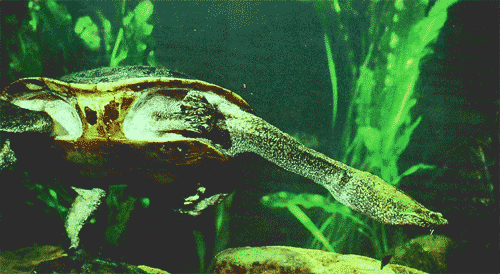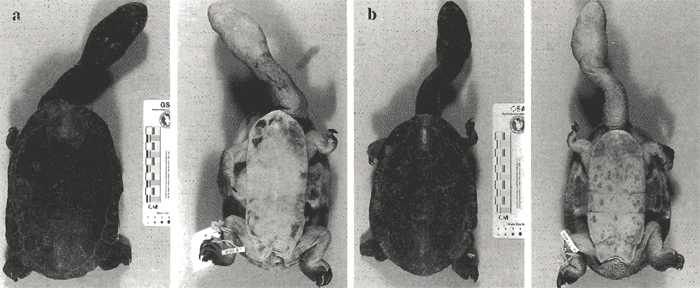| |
Diagnosis.—A medium to large snake-necked chelid turtle assigned to the genus Chelodina most closely resembling its sister taxon, from the Kimberley, referred to hereafter as Chelodina sp. (Kimberley). It belongs in the subgeneric group “B” or the Chelodina expansa group (Goode, 1967; Burbidge et al., 1974; Rhodin and Mittermeier, 1976) which includes described forms Chelodina expansa, Chelodina rugosa, Chelodina seibenrocki and Chelodina parkeri. This subgeneric group is distinguished from the Group "A" species (the Chelodina longicollis group) by their relatively longer thicker necks, reduced plastra, broader heads, and a more attenuated mode of strike-and-gape feeding (excluding Chelodina oblonga from this comparison). Chelodina burrungandjii can be distinguished from other members of the C. expansa group by the presence of a relatively shortened, broad, flat head. Chelodina expansa does have a flattened head but not short and broad and even similarly sized individuals are readily identified (Figure 3-4). The oblong shaped carapace and plastron in the adults readily distinguishes this species from all other members of this group except the Kimberley form (Table 2) and the upward turning of the lateral marginals distinguishes this species from C. rugosa, C. seibenrocki and C. parkeri. (Figure 5-6).
The speckled neck colouration is not found among other Australian members of this group, though it is apparent but not as strongly defined in the Kimberley form. It is not as pronounced as that seen in C. parkeri from which C. burrungandjii can also be distinguished by the lack of the pronounced head striping and post-tympanic white patch, key characters for C. parkeri (Rhodin and Mittermeier, 1976; Pritchard, 1979).
Unique among the members of the C. expansa group is the consistent presence of an expanded contiguous neural series of between three and five neurals (Thomson and Georges, 1996) (Figure 5a.). This feature readily distinguishes it from the Kimberley form which has the usual C. expansa group condition of no exposed neurals. Apart from the broad flat skull (Table 3), this species also possesses narrow crista paroccipitalis and pterygoids with enlarged ventro-lateral processes that extend to the condylus mandibularis. |
|
Multivariate Comparisons.—Canonical discriminant analysis (SAS Institute, 1988) was used to determine the distinctiveness of C. burrungandjii and its two closest relatives (based on analysis of electrophretic data of Georges and Adams in prep.), C. rugosa and Chelodina sp. (Kimberley).
Males and females were analysed separately. Head measurements were expressed as a ratio of head length (HL); head length and all shell measurements were expressed as a ratio of carapace length (CL). A number of composite variables were defined as combinations of the raw measurements, but none were retained by the subsequent analyses.
Generalised multivariate distances between all taxa in the C. expansa group, obtained from a discriminant analysis with all raw measurement ratios included, are presented in Table 4 as an indication of their general morphological similarity. Note that the distinction between C. rugosa and C. burrungandjii is substantial (25.3 units), and greater than the distance between C. rugosa and C. parkeri (16.1 units), in support of our recognition of C. rugosa and C. burrungandjii as separate species.
Stepwise selection (significance level for entry = 0.05; for removal = 0.10) was used to obtain a subset of the original variables that provided best discrimination. For females, this yielded the subset of head measurements HL, HH, HWT, HWJ and the shell measurements CW4, CW8, and PLR. Clearly, both head shape and shell shape are well represented in the final formula that provided best discrimination. Discrimination was good (Fig. 7). An indication of the strength of discrimination is given by cross-validation (SAS Institute, 1988), though it does rely on assumptions of normality, unlikely to be strictly upheld because not all animals were the same overall size and growth is allometric. Nevertheless, only two of the 50 animals in the analysis were misclassified. One C. burrungandjii was misclassified as the Kimberley taxon, and vice versa. The distinction between C. rugosa and the other two forms was 100%.
|
|


